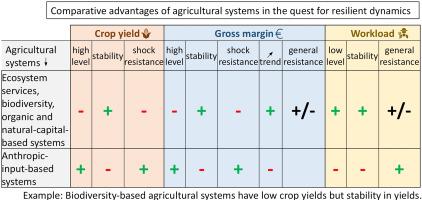Agricultural Systems ( IF 6.1 ) Pub Date : 2022-01-21 , DOI: 10.1016/j.agsy.2022.103365 Manon Dardonville 1, 1, 2 , Christian Bockstaller 1 , Jean Villerd 1 , Olivier Therond 1

|
CONTEXT
New types of farming systems have emerged in response to societal demands to reduce environmental impacts and dependence on non-renewable resources. These agriculture models can be classified according to their relative use of anthropic inputs or biodiversity and associated ecosystem services as agricultural production factors. All these models are exposed to climate change, price volatility and other disturbances. However, little is known about their resilience levels and the factors that drive them.
OBJECTIVE
We assessed the resilience of 30 highly contrasted cropping agroecosystems in north-eastern France which covered a broad gradient from simplified and intensified to complex and biodiversity-based agroecosystems.
METHODS
We applied a quantitative analysis of the dynamics of three key performances over eight years: yield, gross margin and workload. An original combined set of adapted criteria − level, variability, trend and resistance − was used to assess their dynamics, i.e. their resilience. We use partial least squares regression, multiple regression trees and Pareto ranking to identify relationships among the characteristics and resilience performance of these systems.
RESULTS AND CONCLUSIONS
The results showed that biodiversity-based agroecosystems, which provide a high level of ecosystem services to farmers or an increase in natural capital, tended to have stable performances. These systems also had a lower workload than intensified systems. Conversely, input-based systems, especially irrigated and tillage-intensive systems, had higher yields and gross margins, were resistant to major disturbances but were less stable.
SIGNIFICANCE
While our results show benefits of relying on biodiversity to stabilise system performances, we highlight a potential trade-off between performance level and stability, as well as possible solutions to overcome it. We also discuss the short-term strategy of anthropic input-based systems, which perform well, but consume large amounts of human and natural resources. We show potential advantages of systems that balance both ecosystem services and anthropic inputs to provide a strategy to fill the yield gap and attain resilience.
中文翻译:

农业系统的复原力:基于生物多样性的系统是稳定的,而集约化系统具有抗性和高产
语境
新型农业系统应运而生,以应对减少环境影响和对不可再生资源依赖的社会需求。这些农业模型可以根据它们对人为投入或生物多样性和相关生态系统服务作为农业生产要素的相对使用进行分类。所有这些模型都受到气候变化、价格波动和其他干扰的影响。然而,人们对它们的复原力水平和驱动它们的因素知之甚少。
客观的
我们评估了法国东北部 30 个高度对比的种植农业生态系统的复原力,涵盖了从简化和集约化到复杂和基于生物多样性的农业生态系统的广泛梯度。
方法
我们对八年来三个关键绩效的动态进行了定量分析:产量、毛利率和工作量。一套原始的组合适应标准——水平、可变性、趋势和阻力——被用来评估它们的动态,即它们的弹性。我们使用偏最小二乘回归、多元回归树和帕累托排序来识别这些系统的特征和弹性性能之间的关系。
结果和结论
结果表明,为农民提供高水平的生态系统服务或增加自然资本的基于生物多样性的农业生态系统往往表现稳定。这些系统的工作量也低于强化系统。相反,以投入为基础的系统,尤其是灌溉和耕作密集型系统,具有更高的产量和毛利率,能够抵抗重大干扰,但稳定性较差。
意义
虽然我们的结果显示了依靠生物多样性来稳定系统性能的好处,但我们强调了性能水平和稳定性之间的潜在权衡,以及克服它的可能解决方案。我们还讨论了基于人为输入的系统的短期策略,该系统性能良好,但消耗大量人力和自然资源。我们展示了平衡生态系统服务和人为投入的系统的潜在优势,以提供填补产量差距和实现弹性的战略。











































 京公网安备 11010802027423号
京公网安备 11010802027423号